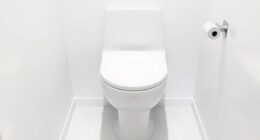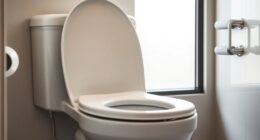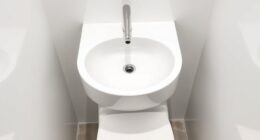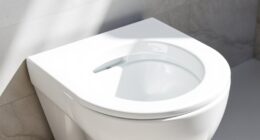- Impact of a broken float assembly on water conservation.
- Steps to troubleshoot a broken float assembly in a toilet
Did you know that the most common reason toilets fail to refill is due to a faulty fill valve?
Understanding the reasons behind a toilet not refilling is essential for anyone seeking mastery in plumbing. In this article, we will explore the technical aspects of why a toilet may not be refilling, including clogged supply lines, water pressure issues, malfunctioning flappers, and broken float assemblies.
Get ready to troubleshoot and fix your toilet refill problems with our informative guide.
Key Takeaways
- The most common reason for toilets failing to refill is a faulty fill valve.
- A clogged supply line can also cause incomplete refilling after flushing.
- Low water pressure can result in incomplete refilling, and bleeding the air out of the supply line can help restore proper pressure.
- A malfunctioning flapper or broken float assembly can also prevent the tank from refilling properly. Regular inspection and maintenance of these components are important.
Faulty Fill Valve
The faulty fill valve is a common cause of a toilet not refilling properly. When the fill valve is faulty, it can result in various issues such as toilet leaking and toilet running.
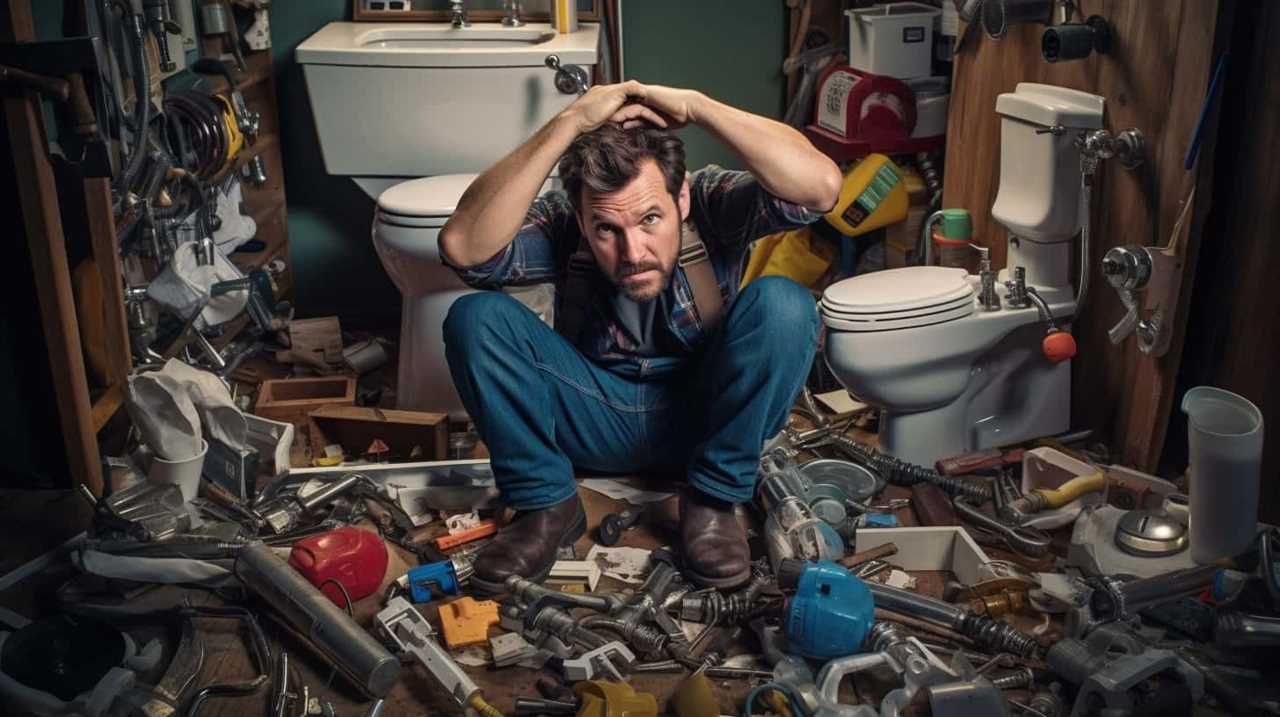
The fill valve is responsible for regulating the flow of water into the tank after a flush. If it isn’t functioning correctly, it can cause water to continuously leak into the bowl or prevent the tank from refilling properly.
This can lead to water wastage, higher water bills, and potential damage to the toilet and surrounding areas. To address this problem, it’s important to inspect the fill valve for any signs of damage or wear.
Replacing the faulty fill valve with a new one can help restore the proper functioning of the toilet and prevent further issues.
Clogged Supply Line
To continue troubleshooting the issue of a toilet not refilling properly, another potential cause could be a clogged supply line. A supply line blockage can occur when debris or mineral deposits accumulate and restrict the flow of water into the toilet tank. This can result in a slow or incomplete refill after flushing. To determine if the supply line is blocked, you can disconnect it from the toilet tank and inspect it for any obstructions. If you find a blockage, you can use a pipe snake or a wire hanger to clear it. It’s important to note that if the supply line is clear and the toilet is still not refilling properly, it may indicate a different issue, such as toilet bowl cracks or a faulty fill valve. In such cases, it’s best to consult a professional plumber for further assistance.

| Potential Cause | Solution |
|---|---|
| Clogged Supply Line | – Disconnect the supply line from the toilet tank. – Inspect for blockages. – Clear any obstructions using a pipe snake or wire hanger. – Reconnect the supply line and test the toilet for proper refilling. – If issue persists, consult a professional plumber. |
Water Pressure Issues
Now let’s address another potential cause for a toilet not refilling properly: water pressure issues.
Low water pressure can prevent the tank from refilling at the desired rate, leading to incomplete flushing and refilling cycles. One common issue that can affect water pressure is the presence of air in the supply line. When air enters the line, it can disrupt the flow of water and decrease the pressure, resulting in a slow or incomplete refill.
To fix this problem, you can try bleeding the air out of the supply line by turning off the water supply to the toilet, flushing it once to release any remaining water, and then turning the water supply back on. This should help restore proper water pressure and ensure a complete refill.
Now, let’s move on to discussing the next potential cause: a malfunctioning flapper.

Malfunctioning Flapper
Moving on from water pressure issues, another possible cause for a toilet not refilling properly is a malfunctioning flapper.
The flapper is a rubber seal that opens and closes to allow water to flow from the tank into the bowl during a flush. If the flapper isn’t functioning correctly, it can prevent the tank from refilling after a flush.
Here are some troubleshooting tips for flapper issues:
- Inspect the flapper for any signs of damage or wear.
- Clean the flapper and the area around it to remove any debris or mineral deposits.
- Adjust the chain length to ensure proper flapper movement.
- Consider replacing the flapper if it’s old or damaged beyond repair.
- Test the flapper by flushing the toilet and observing its performance.
Broken Float Assembly
One possible cause for a toilet not refilling properly is a broken float assembly. The float assembly is responsible for regulating the water level in the toilet tank. When it is broken, it can prevent the tank from refilling properly after each flush. To better understand the importance of the float assembly and its role in toilet tank plumbing maintenance, let’s take a closer look at its components:

| Component | Description |
|---|---|
| Float | A buoyant object that rises and falls with the water level in the tank. |
| Float arm | Connects the float to the fill valve, allowing the float to control the flow of water. |
| Fill valve | Regulates the flow of water into the tank, based on the position of the float. |
| Overflow tube | Prevents the tank from overflowing by directing excess water into the bowl. |
Regularly inspecting and maintaining the float assembly can help ensure proper functioning of the toilet tank and prevent issues with refilling.
Frequently Asked Questions
How Does a Faulty Fill Valve Affect the Toilet’s Water Refill Process?
A faulty float valve can greatly impact the toilet’s water refill process. Sediment build up can cause the valve to malfunction, preventing it from properly closing and allowing water to flow in.
What Are Some Common Signs of a Clogged Supply Line in a Toilet?
Common signs of a clogged supply line in a toilet include slow or incomplete refilling, weak flush, and gurgling sounds. Troubleshooting steps involve checking for obstructions, clearing the line, and ensuring proper water flow.
How Can Water Pressure Issues Contribute to a Toilet Not Refilling Properly?
Water pressure issues can cause a toilet to not refill properly. To troubleshoot, check if the fill valve is clogged or damaged. Water pressure solutions include adjusting the water supply valve or installing a pressure regulator.

What Are the Potential Reasons for a Malfunctioning Flapper in a Toilet?
Potential solutions for a malfunctioning flapper in a toilet can be addressed through troubleshooting techniques. By inspecting the flapper for damage or debris, adjusting the chain length, or replacing the flapper altogether, the issue can be resolved efficiently.
How Does a Broken Float Assembly Impact the Toilet’s Ability to Refill?
A broken float assembly can significantly impact a toilet’s ability to refill. It can lead to water wastage and hinder proper flushing. Troubleshooting steps include checking for leaks, adjusting the float arm, or replacing the faulty assembly.
Conclusion
In conclusion, when your toilet isn’t refilling, it’s usually due to a faulty fill valve, clogged supply line, water pressure issues, malfunctioning flapper, or broken float assembly.
It’s important to address these issues promptly to avoid further inconvenience.

Did you know that a leaking toilet can waste up to 200 gallons of water per day? This staggering statistic highlights the urgency of fixing toilet refill problems to conserve water and protect our precious resources.







